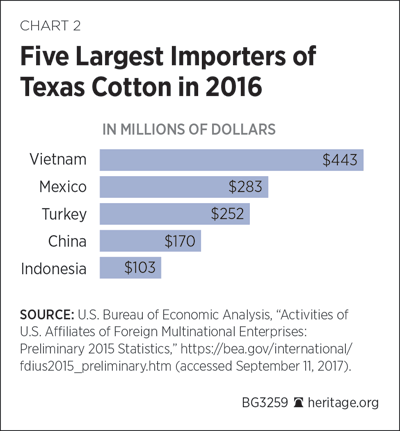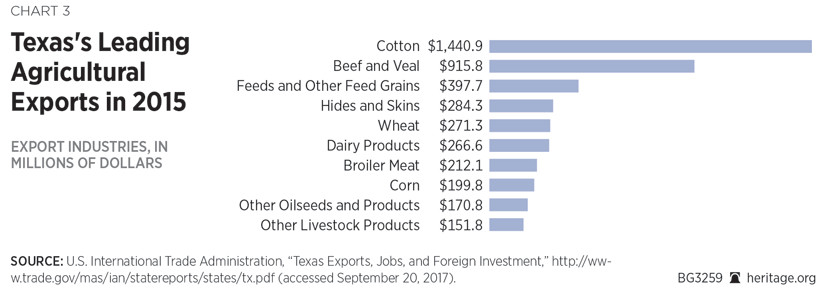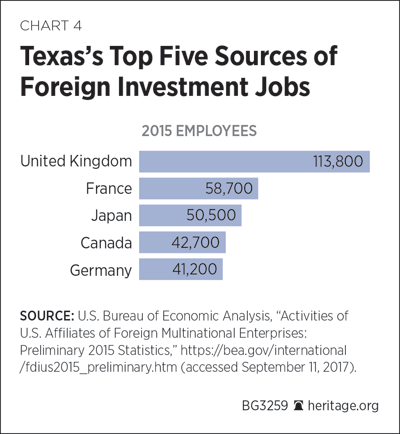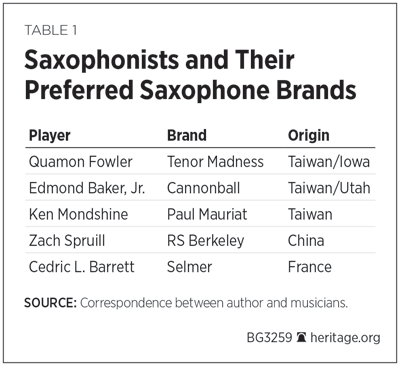The state of Texas leads the nation in economic growth and in international trade.[REF] Were it a country, Texas would have the world’s 10th-largest economy—a ranking achieved in no small part by the state’s deep involvement in international trade and investment.
Specialization and trade are the drivers of all modern economies. Though the scale of specialization varies from product to product, firm to firm, and industry to industry, when workers can each focus on a specific part of the production process, the total output goes up. This is as true today as it was when Adam Smith wrote about specialization in London pin factories in 1776.[REF] The benefits of specialization apply to capital was well as labor. Local, national, and international trade provide the ability for more extensive specialization, and each is an important component of Texas’s economy.
International trade opens up opportunities for producers to sell to a broader market, for consumers to have more choices, and for investment to find its best return. The critical importance of access to broader, international markets is easiest to understand for categories such as petroleum products and cotton, whose outputs are too great for the state-only demand, but this international access is important for most other goods and services, as well.
The benefits of foreign investment to the domestic economy are widely understood. However, it is not widely appreciated that international investment cannot be separated from international trade. The trade in goods and services provides the finance for job-creating investment. The back-and-forth flows of goods and services match the return flows of finance for investment. International trade allows foreigners to invest in Texas, and allows Texans to invest abroad.
As is only fitting, Texas does it all in a big way.
Exports
Texas leads all states in the value of exports. In 2016, Texas exports rang up to more than $230 billion.[REF] The United States’ North American Free Trade Agreement (NAFTA) partners were the largest buyers of the state’s exports. In 2015, Mexico imported over $90 billion of goods and services from Texas. Canada imported over $25 billion worth.[REF]

Widely known as a world leader in petroleum production and refining, Texas actually exported more computer and electronic products in 2016 than it did petroleum and coal products, though these rankings can change from year to year.[REF]
Headquarters for companies like Dell Computers and Texas Instruments, the state hosts scores of information technology companies that have research, development, or production facilities there. These companies read like a Who’s Who of the tech world.[REF] Texas’s $47 billion of computer and electronics exports in 2016 were the most from any state.
Agricultural Exports
Texas ranks near the top among states exporting agricultural products. In 2015, the state’s agricultural exports exceeded $6 billion.[REF] The leading agricultural export is cotton. Texas exports more cotton than the next four states combined.[REF] In 2016, Texas exported $1.7 billion of cotton.[REF] Vietnam is the largest buyer of Texas’s cotton, taking one-quarter of the total.

There is a good chance that a given shirt or pair of jeans imported to the U.S. is made from Texas cotton.
Texas is a major exporter of other agricultural products as well. Nearly one-quarter of Texas’s agricultural production (by value) is exported.[REF]

Employment and Foreign Investment
Good jobs depend on a robust economy. Data in the Heritage Foundation’s Index of Economic Freedom point to a strong relationship between economic freedom and a growing, healthy economy.[REF] In broad terms, the Index measures how much freedom people have to make their own investment, purchasing, and employment decisions without burdensome red tape, mandates, or high taxes.
The strong Texas economy is well served by these values and well served by its involvement in the international economy. Separating jobs according to which ones depend on trade and which do not is very difficult, but some facts help give an idea of the importance of international trade and international investment to the labor market in Texas.
The U.S. International Trade Administration estimates that over one million U.S. jobs are supported by exports from Texas.[REF] Over a half million Texans (5.5 percent of private-industry employment) are employed by foreign-owned companies. Nearly 42,000 companies exported from locations in Texas.[REF]
From 2011 through 2016, foreign direct investment in Texas exceeded $40 billion, adding 84,000 jobs.[REF] Over those years, the top three sources of foreign direct investment in Texas were France, Japan, and Germany.[REF] Recent examples of foreign direct investment include Toyota’s $300 million for its new North American headquarters in Plano; INEOS Oligomers’ $400-million investment in its petrochemical complex in Alvin; and IKO Industries’ new $80-million plant in Hillsboro.[REF]

Benefits of Imports
Though it is easier for some to see the benefits of exports than to see the benefits of imports, the benefits of imports are at least as important. Imports fall into two broad categories: (1) inputs to production (intermediate and capital goods) and (2) consumption goods.
A recent study determined that 60 percent of U.S. imports are purchased by factories and farms.[REF] That is, most imports to the U.S. are used to produce other goods. These intermediate and capital goods range from raw materials unavailable in the U.S. to goods with superior features or more competitive pricing.
When it comes to valuing the imports of consumption goods, one should not forget that the point of earning an income is to be able buy things. In the same way, there would be no point in exporting if nothing were gained in exchange. As with the intermediate and capital goods, imports allow Americans to have goods they are unable to produce, or that provide variety, quality, or prices unavailable in the U.S. For instance, the U.S. is unlikely ever to produce bananas in a quantity demanded by consumers. In addition, inventiveness, innovation, and competitiveness are spread around the globe. Trade allows consumers to benefit from these qualities regardless of where they occur.
The benefits to consumers are too numerous to list—from the year-round variety of fresh fruit and vegetables to the broad choice of automobile performance, features, and style. Still, one example provides an illustration not only of improved consumer choice, but also the difficulty in assigning country of origin.
Ten prominent Texas jazz saxophonists were queried by this author about the brand of saxophone they played. Five were kind enough to respond.[REF] Table 1 shows the musicians and the brand of their saxophones.

Musicians are frequently sensitive to the smallest details of their instruments. In addition, the feel of an instrument can be very personal. An instrument loved by one musician may be harshly disparaged by another. The variety of instruments below is a testimony to this variation in preferences and how trade helps satisfy those preferences.
Selmer is perhaps the best-known saxophone brand and is made in France. RS Berkeley is a relatively new brand and is made in China. Paul Mauriat saxophones are made in Taiwan. The Tenor Madness and the Cannonball saxophones are perhaps the most interesting from a supply-chain perspective. Tenor Madness saxophones are assembled and adjusted in Iowa using parts manufactured in Taiwan. Cannonball saxophones are manufactured in Taiwan, but designed, customized, and given their critical final adjustments in Utah. All of these brands have their die-hard adherents and all cost thousands of dollars. In short, saxophones are not interchangeable commodities. Musicians and their fans benefit from the rich choices that trade provides. Of course, this list is far from exhaustive as there are dozens of other manufacturers from other countries with equally enthusiastic followers.
NAFTA Helps Texas
Though it is difficult to identify all of the jobs that are created by trade, the overall picture of employment since the enactment of NAFTA is positive. Since NAFTA went into force in January 1994, non-farm employment in Texas has risen from 7.6 million to 12.2 million.[REF] Regardless of whether a significant portion of the increase is due to NAFTA, it is clear that the agreement did not lead to the catastrophic job losses some predicted.[REF] In addition, as noted above, NAFTA partners Canada and Mexico are the biggest buyers of Texas’s exports.
Texas’s delegation to Congress anticipated these benefits and voted with an overwhelming, bipartisan majority for the passage of NAFTA. (In fact, 29 of Texas’s 34-member delegation voted for NAFTA).[REF] There was similar overwhelming, bipartisan support for subsequent free trade agreements, including the 1994 Uruguay Round Agreement Act, the 2005 Central American Free Trade Act, the 2011 U.S.–Columbia Free Trade Act, and the 2011 Korea–U.S. Free Trade Act.[REF]
Conclusion
Trade is not a zero-sum contest where one side’s gain comes at the expense of the other side. Instead, trade is a big-picture, win-win process. With trade, consumers and producers receive expanded opportunities for their labor and their products, as well as expanded choices for consumption goods, investment opportunities, and sourcing inputs.
If trade were a contest, though, Texas would be winning.
—David W. Kreutzer is a Senior Research Fellow in the Thomas A. Roe Institute for Economic Policy Studies, of the Institute for Economic Freedom, at The Heritage Foundation.


